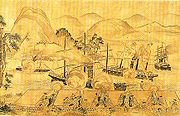
Order to expel barbarians
Encyclopedia


Emperor Komei
was the 121st emperor of Japan, according to the traditional order of succession. Kōmei's reign spanned the years from 1846 through 1867.-Genealogy:Before Kōmei's accession to the Chrysanthemum Throne, his personal name was ;, his title was ....
in 1863 against the Westernization
Westernization
Westernization or Westernisation , also occidentalization or occidentalisation , is a process whereby societies come under or adopt Western culture in such matters as industry, technology, law, politics, economics, lifestyle, diet, language, alphabet,...
of Japan following the opening of the country by Commodore Perry in 1854.
The order
The edict was based on widespread anti-foreign and legitimist sentiment, called the movement. Emperor Kōmei personally agreed with such sentiments, and – breaking with centuries of imperial tradition – began to take an active role in matters of state: as opportunities arose, he fulminated against the treaties and attempted to interfere in the shogunal succession. His efforts culminated on March 11, 1863 with his "Order to expel barbarians". A deadline for the explusion was set two months later to May 11.Consequences
The Shogunate had no intention of enforcing the order, and the Edict inspired attacks against the Shogunate itself as well as against foreigners in Japan. The most famous incident was the firing on foreign shipping in the Shimonoseki Strait off Choshu Province as soon as the deadline was reached. Masterless samurai (rōninRonin
A or rounin was a Bushi with no lord or master during the feudal period of Japan. A samurai became masterless from the death or fall of his master, or after the loss of his master's favor or privilege....
) rallied to the cause, assassinating Shogunate officials and Westerners. The killing of the English trader Charles Lennox Richardson
Charles Lennox Richardson
Charles Lennox Richardson was an English merchant based in Shanghai who was killed in Japan during the Namamugi Incident. His name is properly spelled as “Charles Lenox Richardson” according to the census and family documents.-Merchant:Richardson was born in London in 1834. He relocated to...
is sometimes considered as a result of this policy. The Tokugawa government was required to pay an indemnity of a hundred thousand British pounds for Richardson's death.
But this turned out to be the zenith of the sonnō jōi movement, since the Western powers responded to Japanese attacks on western shipping with the Bombardment of Shimonoseki
Bombardment of Shimonoseki
The Battles for Shimonoseki refers to a series of military engagements in 1863 and 1864, fought to control Shimonoseki Straits by joint naval forces from the Great Britain, France, the Netherlands and the United States, against the Japanese feudal domain of Chōshū, which took place off and on the...
. Heavy reparation
War reparations
War reparations are payments intended to cover damage or injury during a war. Generally, the term war reparations refers to money or goods changing hands, rather than such property transfers as the annexation of land.- History :...
s had earlier been demanded from Satsuma for the murder of Charles Lennox Richardson
Charles Lennox Richardson
Charles Lennox Richardson was an English merchant based in Shanghai who was killed in Japan during the Namamugi Incident. His name is properly spelled as “Charles Lenox Richardson” according to the census and family documents.-Merchant:Richardson was born in London in 1834. He relocated to...
- the Namamugi Incident
Namamugi Incident
The was a samurai assault on foreign nationals in Japan on September 14, 1862, which resulted in the August 1863 bombardment of Kagoshima, during the Late Tokugawa shogunate...
. When these were not forthcoming, a squadron of Royal Naval vessels went to the Satsuma port of Kagoshima to coerce the daimyō
Daimyo
is a generic term referring to the powerful territorial lords in pre-modern Japan who ruled most of the country from their vast, hereditary land holdings...
into paying. Instead, he opened fire on the ships from his shore batteries, and the squadron retaliated. This was later referred to, inaccurately, as the Bombardment of Kagoshima
Bombardment of Kagoshima
The Bombardment of Kagoshima, also known as the , took place on 15–17 August 1863 during the Late Tokugawa shogunate. The British Royal Navy was fired on from the coastal batteries near town of Kagoshima and in retaliation bombarded the town...
. These incidents clearly showed that Japan was no match for Western military might, and that brutal confrontation could not be the solution.
These events, however, also served to further weaken the shogunate, which appeared too powerless and compromising in its relations with Western powers. Ultimately the rebel provinces allied and overthrew the shogunate in the Boshin war
Boshin War
The was a civil war in Japan, fought from 1868 to 1869 between forces of the ruling Tokugawa shogunate and those seeking to return political power to the imperial court....
and the subsequent Meiji Restoration
Meiji Restoration
The , also known as the Meiji Ishin, Revolution, Reform or Renewal, was a chain of events that restored imperial rule to Japan in 1868...
.

